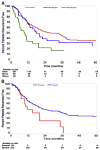Recurrence after operative management of intrahepatic cholangiocarcinoma
- PMID: 23499016
- PMCID: PMC3980567
- DOI: 10.1016/j.surg.2012.12.005
Recurrence after operative management of intrahepatic cholangiocarcinoma
Abstract
Introduction: Data on recurrence after operation for intrahepatic cholangiocarcinoma (ICC) are limited. We sought to investigate rates and patterns of recurrence in patients after operative intervention for ICC.
Methods: We identified 301 patients who underwent operation for ICC between 1990 and 2011 from an international, multi-institutional database. Clinicopathologic data, recurrence patterns, and recurrence-free survival (RFS) were analyzed.
Results: During the median follow up duration of 31 months (range 1-208), 53.5% developed a recurrence. Median RFS was 20.2 months and 5-year actuarial disease-free survival, 32.1%. The most common site for initial recurrence after operation of ICC was intrahepatic (n = 98; 60.9%), followed by simultaneous intra- and extrahepatic disease (n = 30; 18.6%); 33 (21.0%) patients developed extrahepatic recurrence only as the first site of recurrence. Macrovascular invasion (hazard ratio [HR], 2.08; 95% confidence interval [CI], 1.34-3.21; P < .001), nodal metastasis (HR, 1.55; 95% CI, 1.01-2.45; P = .04), unknown nodal status (HR, 1.57; 95% CI, 1.10-2.25; P = .04), and tumor size ≥ 5 cm (HR, 1.84; 95% CI, 1.28-2.65; P < .001) were independently associated with increased risk of recurrence. Patients were assigned a clinical score from 0 to 3 according to the presence of these risk factors. The 5-year RFS for patients with scores of 0, 1, 2, and 3 was 61.8%, 36.2%, 19.5%, and 9.6%, respectively.
Conclusion: Recurrence after operative intervention for ICC was common. Disease recurred both at intra- and extrahepatic sites with roughly the same frequency. Factors such as lymph node metastasis, tumor size, and vascular invasion predict highest risk of recurrence.
Copyright © 2013 Mosby, Inc. All rights reserved.
Figures




References
-
- Kaczynski J, Hansson G, Wallerstedt S. Incidence, etiologic aspects and clinicopathologic features in intrahepatic cholangiocellular carcinoma—a study of 51 cases from a low-endemicity area. Acta Oncol. 1998;37:77–83. - PubMed
-
- Shaib Y, El-Serag HB. The epidemiology of cholangiocarcinoma. Semin Liver Dis. 2004;24:115–25. - PubMed
-
- de Jong MC, Nathan H, Sotiropoulos GC, et al. Intrahepatic cholangiocarcinoma: an international multi-institutional analysis of prognostic factors and lymph node assessment. J Clin Oncol. 2011;29:3140–5. - PubMed
-
- Nuzzo G, Giuliante F, Ardito F, et al. Intrahepatic cholangiocarcinoma: prognostic factors after liver resection. Updates Surg. 2010;62:11–9. - PubMed
MeSH terms
Grants and funding
LinkOut - more resources
Full Text Sources
Other Literature Sources
Medical

